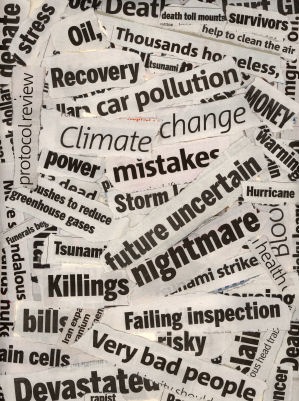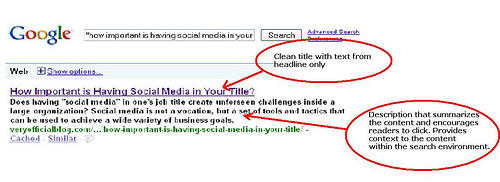Guest Post by Shannon Paul, Read her blog | Follow her on Twitter

Image Credit: Gakuranman
Content may be king, but it won’t ever get the royal treatment outside the confines of your company’s website unless its dressed for success with a killer headline and description to match. A lot of interest can be generated with great content and some proper positioning. Positioning, in this case means solid headlines and descriptions to accompany the content at a variety of access points across the web.
Not Just Newsworthy, but Worthy of Attention
Those of us in PR tend to think of our content as it relates to other content being generated in the media, but that’s not enough anymore. On the social web, what the media creates is only part of the equation. It’s more important than ever that the content we create for our companies and clients be consumable — at least in part beyond the sovereign borders of our own websites.
Content Without Context
Whether we like it or not, content we create, no matter how brilliant it may be, is only as relevant as what’s happening in the rest of the world. Good PR pros get this, but if we need to leverage content across the web, context includes consumption in outlying areas like Google, Facebook and Twitter.
Most of us in PR are accustomed to creating content that gets cut, pasted, repurposed and recycled by journalists to use in their content that is ultimately consumed by individuals.
However, we need to get accustomed to the idea that our content will not only be parsed by professionals, it will be consumed as intended (on our own websites) and a la carte (on social networks).
If we want the content we create to be found by individuals and journalists alike, as well as shared by individuals in social networks, we need to not only think about how our pitch looks in a journalist’s inbox, but if we’re really serious about measuring ROI, we need to think about how the content we create will show itself on search engines and posted to places like blogs and Facebook.
Make Headlines Relevant for Readers
There’s a lot of great guidance out there on writing killer headlines for online content and PR pros are wise to pay attention. Letting the lawyers do the editing, or worse, folding under pressure to name every project stakeholder in the headline is a mistake.
Copyblogger has a wealth of guidance for writing attention-getting headlines that deliver results and for good reason: Roughly 80 percent never read beyond the headline. That means they don’t click and they don’t care about the details. Any campaign hoping to leverage the power of word-or-mouth had better have great headlines that contain words and phrases people are searching for. If you’re not sure what keywords your readers are searching for in relation to your company, use Google Adwords Keyword tool, or Google Trends for guidance, but don’t go crazy trying to write for search. Use this information as a guideline, but remember to write for people – not search engine bots.
Start paying attention to the headlines that get you to click and compare your company’s press releases or article headlines in a side-by-side comparison. How do you measure up?
The Role of Descriptions in Generating Interest
Descriptions are extremely easy to overlook, but they may cost you lots of traffic to your website. Even though descriptions often don’t show up on the actual article, they do show up in search and when items are shared to social networks like Facebook.
In the absence of a description tag, search engines will simply render the lead paragraph, at least in part. Sometimes this actually works, but more often than not, it doesn’t really do the trick. Imagine if Amazon posted the first few opening lines from a film on a DVD description page rather than a plot summary or synopsis. What tactic would be more effective at generating interest?
Google Improvises When Descriptions Are Ignored By Content Creators
Here is an example of what a search result looks like when there is no description tag – in other words, here’s what NOT to do:
As you can see in this example, the metadata embedded in the template to show the comments on this particular blog post shows up as an awkward “jump to comments” and the lead paragraph doesn’t exactly work in this case. Another classic blunder is the fact that the headline is repeated in the description. So, this valuable real estate within a search result is wasted with irrelevant and redundant information.
If this item were to show up as one of several hundred thousand other posts on a similar topic, why would someone click on this?
The nice thing about descriptions is that this is one place where it actually helps to pile on the positive spin, but limited to about 30 words or less.
To make the most of your meta description tags, have them extrapolate on the headline and serve as the article’s advertisement. This is one place where it’s okay to say ‘look at me!’
Here is an example of the same headline and description optimized for search:
In this example, I removed the extra text from the headline and wrote a description that expanded upon the title of the blog post. This way, the content appears more relevant to someone searching for this type of content. This also helps to ensure that the RIGHT people are accessing this content – meaning, this content is much better aligned to attract interested readers and visitors to the site.
I know it’s tempting for PR pros to simply focus on writing and pitching, but the context for this type of work is changing. Shouldn’t we help position or press materials and other editorial content in the best possible way for all interested members of the public to access and enjoy? This way they’re much more likely to pass it on, link to it, and reference it in the content they create.







Excellent post. Go WINGS!!
I would like 2 add: Your Blog Headline = Your Tweet Thru Twitterfeed.com!
Great post, very relevant and current. You didn’t fail, the headline did catch our attention. Thanks for sharing.
The headline caught my attention, and I appreciate the body of the post. Basic stuff really. A lot of observers have noted how PR materials today have evolved or should evolve to account for the dramatic transformation in communications. Press/news releases are no longer for journalists eyes only. Rather, they’re for all of the audiences who you care about and who care about you. Bottom line… we need to make our content more accessible than ever before. Communicators are masters at getting the message OUT… but we really need to focus even more on getting the message IN to minds and hearts. It’s not just about getting attention, though that counts. It’s about engagement. It’s always been about the latter, hasn’t it?
The headline didn’t catch my attention but the author did–by writing a catchy headline in one of those social networking outposts she references. And therein lies the rub: Don’t focus a headline and metatag data solely for the source where you hope everyone goes to directly, but also for everywhere else you are promoting and interacting to draw people to the source.
Very good advice and something we should be thinking about. Thanks.
Love your writings Shannon, but I actually think you fail on this one!
Context, as you say, is very important. And when headlines operate without context, they need to convey meaning and grab attention. FROM THE INTENDED AUDIENCE.
I think your headline will grab the attention of people interested in headlines.. but is this post for them or for PR people? Are they the same?
Maybe : “If This Headline Doesn’t Catch PR Professionals Attention, I Failed” would work better?
Maybe: “Why PR Professionals Fail when writing headlines” or “Is your headlines causing your PR strategy to fail?”
Sorry for being such a nit-picker .. 🙂 .
what a great site 🙂 keep it up.
i agree. headline should always be an eye- and attention-catcher. this is the only motivating factor for the audience to go on and read. my website was set-up by Prova and i make sure that headlines really stand out. in that way, results are overwhelming.